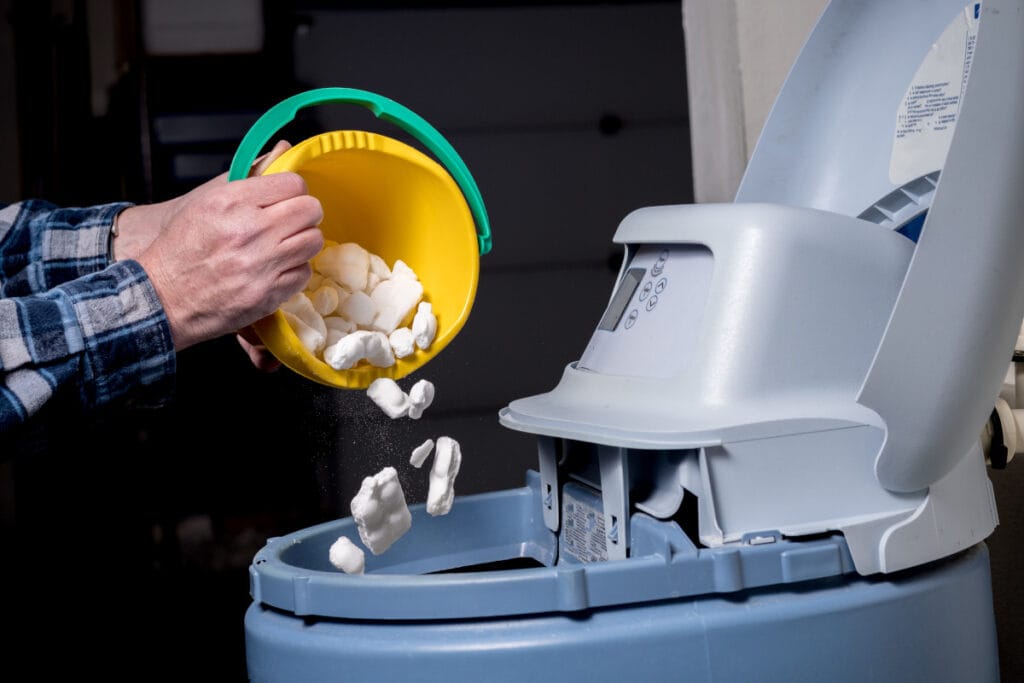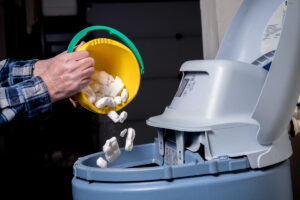When should salt be added to water softeners for regeneration?

Water softener maintenance adding more salt when needed
Are you tired of dealing with calcium deposits on your faucets and soap scum in the bathtub? If so, a water softener may be just what you need to combat these common issues caused by hard water. Water softeners are devices that help remove minerals like calcium and magnesium from your water supply, ensuring that you have access to clean and softened water throughout your home.
But owning a water softening system comes with its own set of responsibilities. One crucial aspect is knowing when to add salt for regeneration purposes. Just like any other appliance, regular maintenance is key to keeping your water softener running efficiently and prolonging its lifespan. That’s why understanding the right timing for adding salt to regenerate your system is essential.
In this article, we will delve into the topic of when exactly you should add salt to your water softeners for regeneration purposes. We will outline why periodic regeneration plays a critical role in maintaining optimal efficiency, preventing costly repairs down the line. So grab yourself a cuppa or beverage of choice as we explore how proper salt replenishment can make all the difference in keeping your household’s tap waters gentle on skin and clothes alike!
Understanding the regeneration process
Water softeners regenerate to remove mineral deposits that build up over time, allowing them to continue effectively removing hardness minerals from your water supply. The regeneration process involves several steps, typically controlled by an automatic timer or a sensor that monitors the hardness level of the water.
During regeneration, the resin bed in the water softener is flushed with a concentrated salt solution (brine) to displace and flush away any accumulated calcium and magnesium ions. This brine solution helps restore the resin beads’ ability to attract and trap hardness minerals once again. Without this essential step, your water softener would lose its efficiency as it becomes saturated with hard minerals.
To ensure optimal performance and longevity of your water softener, adding salt is crucial during every regeneration cycle. The amount of salt required will depend on various factors such as the size of your unit and household water usage. Regularly replenishing salt ensures that there is enough available for each regeneration cycle so that your system can efficiently soften your home’s water supply.
Signs that indicate salt needs refilling
One of the key maintenance tasks for water softeners is regularly replenishing salt to ensure proper regeneration. But how do you know when it’s time to add more? There are several signs that can indicate your water softener needs a refill of salt.
The first sign is a decrease in the effectiveness of your system in removing hardness minerals from the water. If you notice an increase in scale buildup or spots on dishes and fixtures, it may be a sign that your water softener is not functioning optimally due to low salt levels.
Another indicator is increased usage of soap and detergent. When there isn’t enough salt available for regeneration, the resin beads in the system become less efficient at exchanging hardness minerals like calcium and magnesium ions with sodium ions. This can result in soaps and detergents needing to work harder to produce desired lather or clean effectively.
It’s important to note that these signs may vary depending on the type of water softening system you have. For example, if you have a timer-based system where regeneration occurs at set intervals, you might start noticing these signs near the end of the cycle as there will be less dissolved sodium available for ion exchange. On-demand or demand-initiated systems use sensors or meters to monitor water usage and regenerate only when necessary, which means signs could appear earlier if there is high demand without enough salt stored.
Being aware of these indicators can help homeowners proactively monitor their systems and avoid potential issues caused by low salt levels. Regularly checking for these signs ensures optimal performance and extends the lifespan of your valuable investment in a water softening system.
Determining frequency of salt addition
The frequency at which salt needs to be added to your water softener for regeneration will depend on several factors. First and foremost, the size of your household plays a crucial role in determining how often you will need to replenish the salt supply. A larger household that uses more water on a daily basis will require more frequent refills compared to a smaller household.
Another important factor is the level of water hardness in your area. Hard water contains high concentrations of minerals like calcium and magnesium, which can cause scale buildup and reduce the effectiveness of your water softener over time. If you live in an area with extremely hard water, you may need to add salt more frequently to ensure optimal performance.
Additionally, the type and capacity of your equipment also impact how often salt needs refilling. Different models have different regenerating capabilities and varying levels of efficiency. Some units may require less frequent recharging due to more efficient processes or higher grain capacity.
To determine how often you should add salt for regeneration purposes, it’s best to consult your owner’s manual or reach out to the manufacturer directly. They can provide specific guidelines based on their equipment’s specifications as well as offer recommendations tailored to factors such as local water conditions.
By considering these factors and understanding when it is necessary for replenishing salt in your system, you can ensure that your water softener continues operating effectively while prolonging its lifespan.
Best practices for adding salt
Properly adding salt to your water softener is crucial for its effective regeneration. Follow these step-by-step instructions to ensure a seamless process and maintain the optimal performance of your system.
- Check the salt level: Before adding more salt, it’s essential to check the current level in your brine tank. Generally, you should aim to have at least three inches of salt above the water level. If the level is lower than that, it’s time to replenish.
- Choose the right type of salt: There are different types of salts available for water softeners, including evaporated salt pellets, solar crystal salts, and rock salts. Consult your manufacturer’s guidelines or user manual to determine which type is recommended for your specific system.
- Avoid overfilling: When adding new salt, make sure not to overfill the brine tank beyond its capacity. Overfilling can cause issues like clogging or bridging – when solidified crust forms on top of undissolved chunks – which may prevent proper flow during regeneration.
- Ensure consistent supply: It’s a good practice always to keep some extra bags of salt handy so that you never run out unexpectedly when your system requires regeneration.
By following these best practices and properly maintaining the salt level in your water softener, you’ll ensure continuous production of softened water without any interruptions caused by inadequate regenerating processes or insufficient availability of sodium ions from depleted resin beads.
Benefits of regular salt maintenance
Regular salt maintenance plays a critical role in prolonging the lifespan of your water softener system. By replenishing the salt in your water softening system on a regular basis, you can ensure that it continues to function optimally and efficiently.
One of the main benefits of regularly adding salt to your water softener is improved overall water quality. The purpose of a water softening system is to remove minerals such as calcium and magnesium from the incoming hard water. When these minerals accumulate in your system, they can hinder its performance and result in less effective regeneration cycles. By maintaining proper salt levels, you allow for efficient ion exchange during regeneration, ensuring that these minerals are effectively removed from the resin bed and your home’s water supply remains softened.
Another benefit of regular salt maintenance is increased energy efficiency. An adequately maintained water softener operates more efficiently than one with low or no salt levels, leading to lower energy consumption and reduced utility bills over time. Without enough dissolved salts present for proper regeneration, the resin beads become less effective at removing hardness-causing minerals from the incoming hard water. This results in increased pressure drops within the system and decreased flow rates—both requiring extra energy to compensate for inefficiencies.
In conclusion, regular salt maintenance offers multiple benefits for both prolonging the life span of your water softening system and maintaining high-quality softened water throughout your home while reducing energy consumption costs over time.
Troubleshooting common issues
While water softeners can significantly improve the quality of your water, they are not immune to occasional problems. Two common issues that homeowners may encounter with their water softening systems are bridging and salt mushing. However, with a bit of troubleshooting know-how, these problems can be easily resolved.
Bridging occurs when the salt inside the brine tank forms a crust or solid layer above the water level. This prevents proper mixing and dissolving of salt during regeneration, resulting in hard water flowing through your pipes. To troubleshoot bridging, first, turn off the system and carefully break up any hardened salt bridge using a broom handle or another long tool. Then ensure that you always have enough water in your brine tank to dissolve the salt properly by keeping it at least half full.
Salt mushing, on the other hand, happens when fine granulated or pelletized salts compact together into a sludge-like substance at the bottom of the brine tank. This can impede effective resin-bed regeneration and reduce overall efficiency. If you suspect salt mushing is occurring in your system, carefully scoop out any compacted material from the bottom of your brine tank without disturbing or removing too much undissolved salt from above. Lastly, consider switching to coarse solar or rock salts instead of fine salts as they tend to minimize this issue.
By addressing these common issues promptly and employing preventive measures such as regular inspection and maintenance routines for your water softener system, you will ensure its optimal performance year-round without compromising on softened water quality for yourself and your family.
Conclusion
To ensure the optimal performance and longevity of your water softening system, it is important to maintain a regular schedule for adding salt. By understanding when to add salt for regeneration purposes, you can prevent scaling and extend the lifespan of your appliances, pipes, and fixtures.
In summary, it is recommended that you check the salt level in your brine tank at least once a month. If the salt level is below one-third full or if there are visible signs of bridging or mushing in the tank, it’s time to replenish with more salt. Remember to use high-quality solar or evaporated pellets as they dissolve effectively and contain less impurities.
By following these guidelines and keeping up with regular maintenance tasks such as cleaning out any debris from the brine tank or inspecting resin beads periodically, you can enjoy softened water throughout your home consistently. Don’t underestimate the importance of proper care for your water softener – it will save you money on repairs down the line while ensuring that every shower feels luxurious and every glass sparkles crystal clear!
